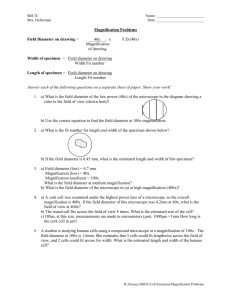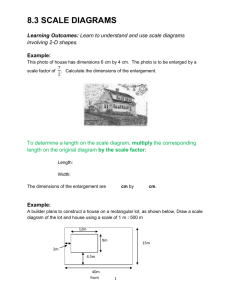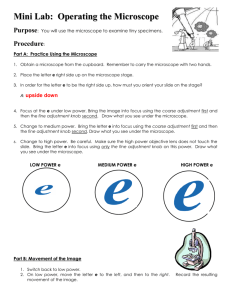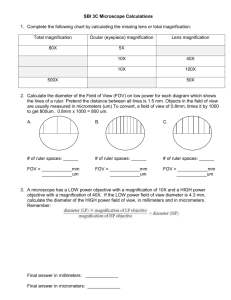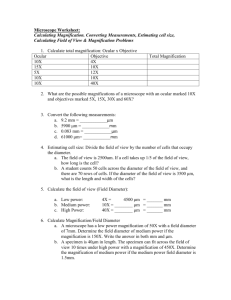The Compound Microscope and Calculations
advertisement
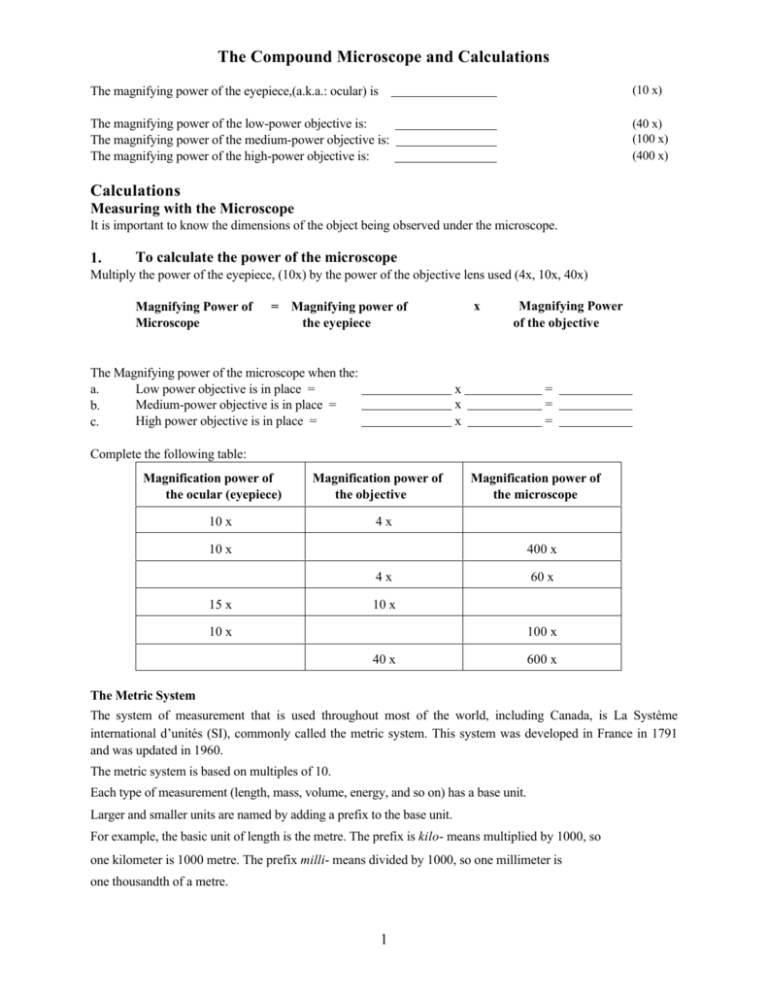
The Compound Microscope and Calculations The magnifying power of the eyepiece,(a.k.a.: ocular) is (10 x) The magnifying power of the low-power objective is: The magnifying power of the medium-power objective is: The magnifying power of the high-power objective is: (40 x) (100 x) (400 x) Calculations Measuring with the Microscope It is important to know the dimensions of the object being observed under the microscope. 1. To calculate the power of the microscope Multiply the power of the eyepiece, (10x) by the power of the objective lens used (4x, 10x, 40x) Magnifying Power of Microscope x = Magnifying power of the eyepiece The Magnifying power of the microscope when the: a. Low power objective is in place = Medium-power objective is in place = b. High power objective is in place = c. Magnifying Power of the objective x x x = = = Complete the following table: Magnification power of the ocular (eyepiece) Magnification power of the objective 10 x Magnification power of the microscope 4x 10 x 400 x 4x 15 x 60 x 10 x 10 x 100 x 40 x 600 x The Metric System The system of measurement that is used throughout most of the world, including Canada, is La Système international d’unités (SI), commonly called the metric system. This system was developed in France in 1791 and was updated in 1960. The metric system is based on multiples of 10. Each type of measurement (length, mass, volume, energy, and so on) has a base unit. Larger and smaller units are named by adding a prefix to the base unit. For example, the basic unit of length is the metre. The prefix is kilo- means multiplied by 1000, so one kilometer is 1000 metre. The prefix milli- means divided by 1000, so one millimeter is one thousandth of a metre. 1 The table shows the most commonly used metric prefixes. Prefix gigamegakilohectodeca- Symbol G M k h da decicentimillimicronano- d c m F n Conversion factors: 1 cm = 10 mm = 10 -2 m Complete the following conversions: a) 2.7 cm = ___________ mm Relationship to the Base Unit 10 = 1 000 000 000 106 = 1 000 000 103 = 1000 102 = 100 101 = 10 100 = 1 10-1 = 0.1 10-2 = 0.01 10-3 = 0.001 10-6 = 0.000 001 19-9 = 0.000 000 001 9 1 mm = 1000 Fm = 10 -3 m 1 cm = 10 000 Fm = 10 -6 m b) 1.5 mm = ___________ Fm c) 26.1 mm = _______________Fm d) 19.2 cm = ___________ mm e) 0.30 mm = ______________Fm f) 4.2 Fm = ______________ mm g) 30 mm = ______________ cm h) 10 Fm = _______________ cm i) 0.0574 cm = ___________ Fm 645 Fm = _______________ mm j) 2 The circle of light seen through the microscope is called the field of view. It is the area of a slide that you can observe. The distance across the field of view is called the field diameter. The actual measurements for the field diameters of objectives lenses on the microscopes are known, they are listed below on the table: objective lens Field diameter (mm) 4x 4.5 10 x 1.8 40 x 0.45 Field diameter (Fm) 1800 2. To calculate the actual size of the object a. b. c. Place objects at the edge of the field of view. Estimate how many of the objects fit across the diameter of the field of view. Record the objective lens that has been used and the diameter of this objective lens (from the table above). Calculate the actual size by using the following formula: Actual Size of Specimen = field diameter # of specimens fitting across the field diameter Example 1: A student was examining strands of his hair under a microscope at medium power, (∴field diameter = 1800 µm ). He estimated that when measured width-wise, 20 strands of his hair would fit across the diameter of the field of view. What is the actual width of each hair strand? Actual Size of Specimen = field diameter # of specimens fitting across the field diameter = 1800 µm 20 = 90 µm ∴ each hair is 90 µm in width Example 2: A cheek cell as observed through the 4x objective lens, (∴field diameter = 4.5 mm ). The number of cheek cell that were estimated to fit across the diameter of field of view were 3.5 Estimate the actual width of the cheek cell. State your answer in mm. (Answer: width of the cheek cell = 1.3 mm) 3 3. To calculate the magnification of a drawing Magnification: the comparison of the actual size of the object with the size of its image is referred to as magnification. To calculate the magnification of a drawing a. Record the actual size of the specimen from the above calculations. b. With a ruler measure the length of the drawing of the specimen in the same direction as you estimated the size of the object. This is the drawing size. c. Calculate the magnification of the drawing using the following formula: Magnification of drawing = width of drawing Actual size of specimen (measured with a ruler) Example 1 (See: Calculation 2, Example 1 above) A student was examining strands of his hair under a microscope at medium power, (∴field diameter = 1800 µm ). He estimated that when measured width-wise, 20 strands of his hair would fit across the diameter of the field of view. a. What is the actual width of each hair strand ? Answer: each hair is 90 µm in width. b. Next, the student made a scaled drawing of his hair. He then measured the width of his drawing. It measured 4 mm. What was the magnification of the drawing ? Magnification of drawing = = 4mm 90 µm = 4000 µm 90 µm = width of drawing Actual size of specimen (measured with a ruler) 45 ∴the diagram represents a 45X magnification of the actual specimen 4 Assignment Answer the following questions, showing all the steps. 1. A student is looking at a piece of string using the high power objective lens. She estimates that 5 pieces of string fit width-wise across the field of view. Calculate the width of each piece of string. (Answer: width of each strand = 90 µm) 2. Another student is observing onion cells using the high power objective lens. She estimates that three cells fit across the field diameter width-wise. a. Calculate the actual size of one cell. (Answer: 2.a. Size of one cell = 150 µm) b. The student draws the cell diagram, she determines the width on one onion cell to be 22 mm. Calculate the magnification of the drawing. (Answer: 2.b. Magnification of the drawing = 145x) 3. A student learned that the actual size of a specimen she was examining was 150 µm. She estimated that 10.5 specimens would fit across the field diameter. What objective lens was most likely used. (Answer: objective lens most likely used was 10x) 4. The actual length of a specimen was determined to 795 µm. How long would a diagram of the specimen be if the diagram represented a 180x magnification of the specimen? express your answer (Answer: specimen drawing143100 µm, = 14.3 cm) in centimeters. 5. Ten perfectly square grains of sand were found to fit across the field diameter when the 10x objective lens was in place. What is the actual size of a grain of sand ? (Answer: 5.a. Actual size of one grain of sand = 180 µm) a. b. If the grain of sand was magnified 100 x, how wide was the grain of sand in the drawing ? (Answer: 5.b. specimen drawing = 1.8 cm) 5

